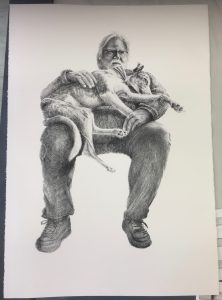I had smart phone photographed Paul on a number of occasions and putting all the images together as if on a photographic contact strip.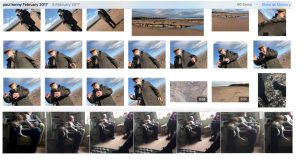
The single all encompassing image is the tradition of portrait painting and photography and artists from time to time have tried to make multi images of a subject in one frame. These approaches are admirable, however many subjects have a wide rage of elements to their character and strings to their individual bows. So two portraits of Paul may give a more insightful representation.
The first : ‘Cheswick Beach Explanations’ with only graphite pencils.
The first print began as a picture in Paul’s home following a long walk on the North Sea coast. Paul had added to his apparel with his cap, scarf, waterproof coat and a small slr camera. Paul is a brilliant photographic image making artist using mesmerising, detailed and time consuming methods to create his images using analogue and digital techniques in his darkrooom/studio. His SLR is more for personal and non artistic use, so to include it in the portrait is a play on his artist practice – i.e. he will invariably never create his art with this camera, but here he has it slung around his neck as if a ‘photographer’. Paul and I were both taught by Geoff Lowe at Newcastle Poly fine art department. I remember Geoff saying in one of his passing remarks that cameras are male jewelery. This stuck with me as a comment on the camera as male appendage way back then in the early 70’s, (nineteen seventies) while I was tussling with images and art created through photography, print, film, book and poster making in the time of ‘conceptual art’. 40 Years on Paul and I have met again through the ubiquitous democracy of social media that has allowed us to connect through the internet, which had only been a glint in Sir Tim Berners Lee’s eye back then.
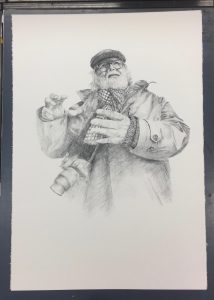
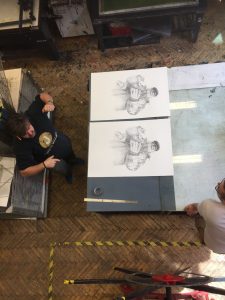
This print is made using a 180 silk screen mesh, emulsion coated once on the print and once on the positive side, dried and exposed for 8 light units. Washed out, dried, stopped out and printed with 3 parts pigment, 3 parts extender and 3 parts retarder. Pigment was composed of 1 part Lascaux indigo and 2 parts system black. Prints were made on Canaletto cotton paper and on Fabrianno Rosapina rag paper. The final print was flooded 6 times and ‘pulled’ once to provide a full inked crisp image with a good range from blacks to whites, shadows to highlights.
The second portrait print ‘Paul Listens and Holds Millie’ was drawn with graphite pencils from HB to 9B on mark resist to assess the different drawing qualities achievable for the range of textures from human to canine, wool to leather.

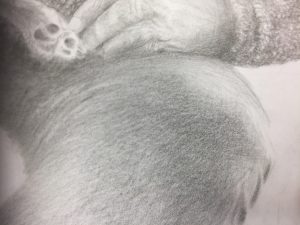
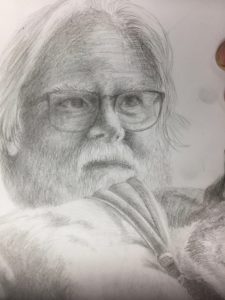

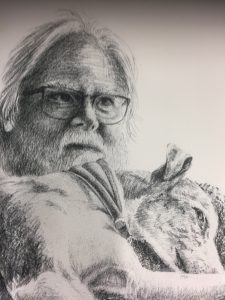
This print is through a 180 mesh screen, Z133 emulsion, coated on both sides and exposed for 8 light units to retain the drawings with graphite pencils on mark resist. The head was drawn with HB and has printed retaining the soft, low contrast drawing.
The print on Canaletto is higher contrast on the ‘flat’ white cotton paper than the softer print on the Fabriano course rag paper. The ink was thickened up with additional pigment 2 parts system black and 1 part indigo Lascaux. The squeegee angle was also increased and thereby increased the pull pressure. The screen was flooded 4 times and two pulls were applied.
